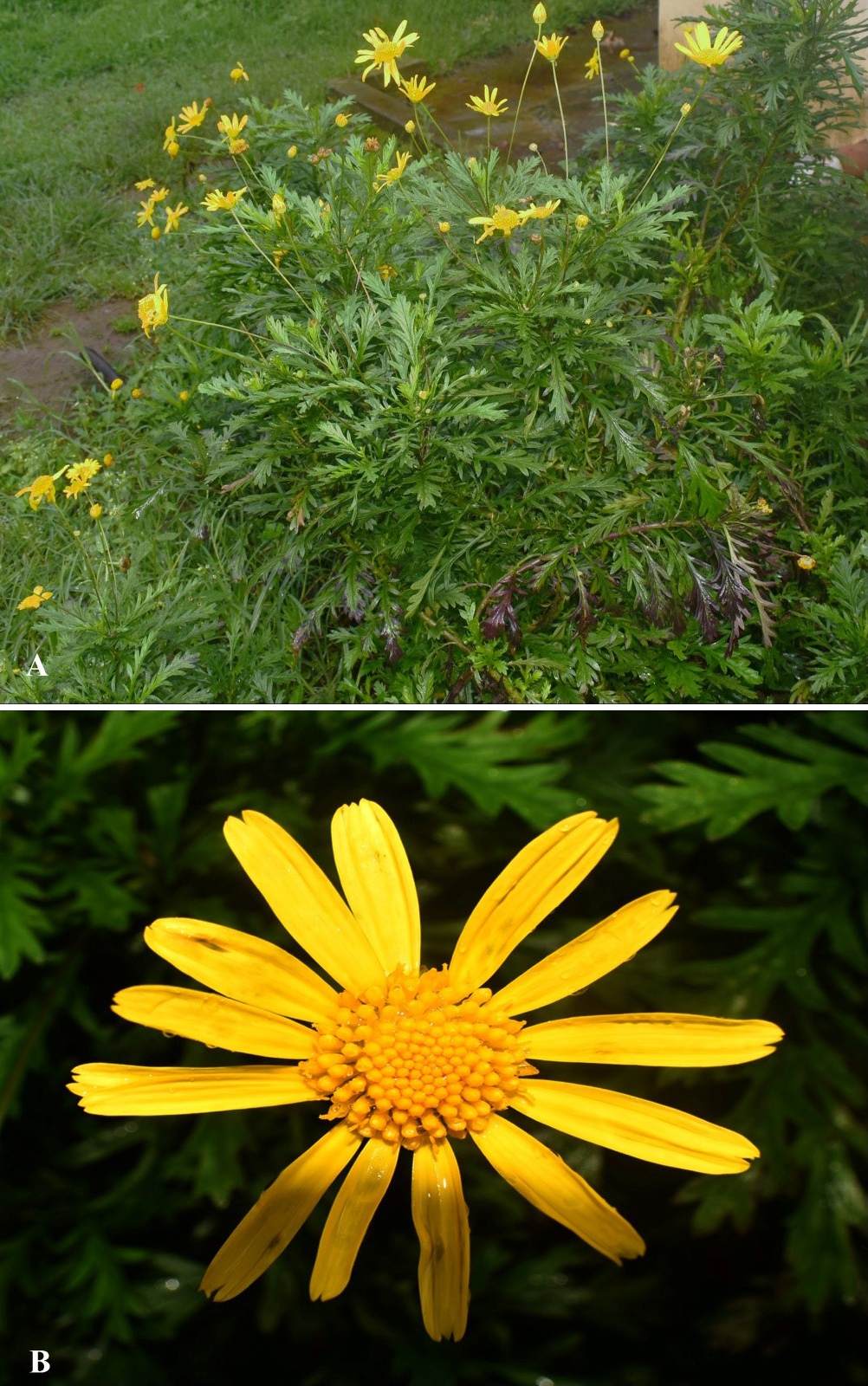INTRODUCTION
Asteraceae is the largest and a cosmopolitan flowering plant family worldwide. The family comprises about 1,172 taxa under 193 genera in India (Karthikeyan et al., 2020). In Tamil Nadu, the family is represented by about 318 taxa under 140 genera including cultivated species (Narasimhan & Irwin, 2021). The genus Euryops of the family Asteraceae belongs to the tribe Senecioneae and is represented by 103 species globally, mainly distributed in NE. & E. Tropical Africa, S. Africa and Arabian Peninsula (POWO, 2022). The species Euryops chrysanthemoides is indigenous to South Africa. The species was introduced for its showy, large flowered capitulum. While working on the family Asteraceae of Tamil Nadu, the authors noticed this species growing in the wild in Pykara of Nilgiri District. Scrutiny of literature (Chandrasekaran, 1987; Rao et al., 1988; Mathur, 1995; Matthew, 1998, 1999; Karthikeyan, Sanjappa & Moorthy, 2009; Karthikeyan et al., 2020; Britto, 2019; Vijaysankar, Ravikumar & Ravichandran, 2011; Narasimhan & Irwin, 2021), revealed that this species is not known from Tamil Nadu. The present communication delivers a detailed description and photo plate for further studies and easy identification.
Euryops chrysanthemoides (DC.) B. Nord. in Opera Bot. 20: 365. 1968. Gamolepis chrysanthemoides DC., Prodr. 6: 40. 1837.African Bush-Daisy, Daisy-Bush, Golden Daisy-Bush, Paris Daisy, Resin-Bush. (Fig. 1)

Figure 1. A. Habit; B. Capitulum close view.
Shrub up to 1 m high, bushy. Stems erect, many branched, woody, glabrous; internodes 1-5 cm long. Leaves simple, crowded, sessile, alternate-spiral, 10-16 × 2-4 cm, glabrous, pinnately lobed; lobes 3-7 pairs, acute-subacute or mucronate at apex; veins prominent on both surfaces, dark greenish. Inflorescence solitary, axillary or terminal head. Peduncle 9-12 cm long, slender, elongate. Receptacle smooth with scars at the base. Capitula 1-many, heterogamous, glabrous. Involucre campanulate; phyllaries c. 15, arranged in 1-whorl, united, yellowish-green, imbricate, 5-5.5 × 2.5-3 mm, ovate-oblanceolate, acute at apex, c. 10 nerved, hairy. Ray florets 10-17, one-whorled, 15-16 mm long, glabrous, yellow; ligules linear-oblong, 12-13 × 2.5-3 mm, 3-10 nerved, 2-3-toothed; equal or unequal, tubular portion short, c. 1 mm long. Disc florets 15-20, tubular, 5-6 mm long, 5-lobed, glabrous except lobes outline; lobes ovate, margin papillate, acute or apiculate at apex, yellow. Androecium 3-3.2 mm long; stamens 5, syngenesious; filaments free, 1-1.2 mm long; anthers linear, 1.8-2 mm long, acute or obtuse at apex. Pistil slender, 4.5-5 mm long, glabrous; stigmatic lobes bifid, flattened, 0.3-0.7 mm long, penicillate at apex. Achenes (young) obovate, 1-1.5 mm long, obscurely ribbed, glabrous, brownish; pappus absent.
Flowering & Fruiting: Throughout the year.
Distribution: Based on available flora and literature there is no distribution of this species in India, however, online sources of Flowers of India, it is mentioned as an introduction in Munnar, Kerala (http://www.flowersofindia.net/catalog/slides/African%20Bush%20Daisy.html). So, it is naturalized only in Tamil Nadu.
Native: Southern Africa
Specimen examined: India, Tamil Nadu: Nilgiris District, Pykara near forest guest house, ±1100 m, 11°27’51.5” N, 76°36’17.9” E, 08.08.2022, M.Premkumar & R.Manikandan 149691 (MH).
Uses: Ornamental as well as cultivated for its evergreen foliage and showy flower.
ACKNOWLEDGEMENTS
The authors are grateful to Dr A.A. Mao, Director, Botanical Survey of India (BSI), Kolkata, and Dr M.U. Sharief, Scientist ‘F’ & Head of Office, Botanical Survey of India, Southern Regional Centre (SRC), Coimbatore for providing facilities and encouragement.
